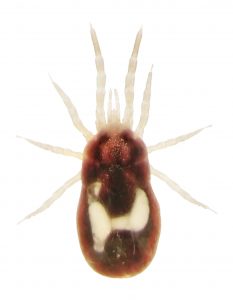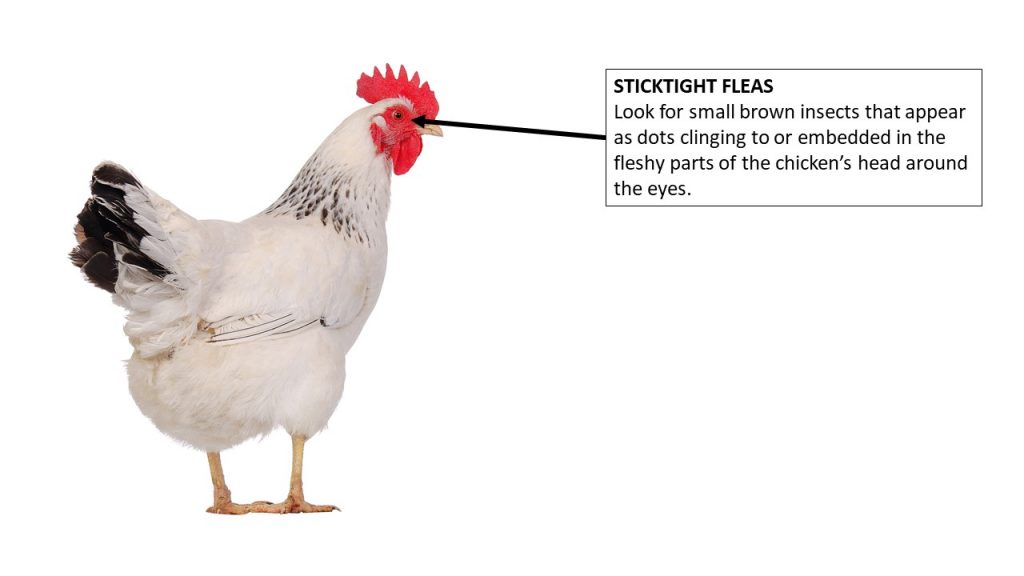Written by: Dr. Jacquie Jacob, University of Kentucky
Parasites are organisms that live in or on another organism, referred to as the host, and gain an advantage at the expense of the host. There are several external parasites that attack poultry by either sucking blood or feeding on the skin or feathers. In small flocks, it is difficult to prevent contact with wild birds (especially English sparrows) and rodents that may carry parasites that can infest poultry. It is important to occasionally check your flock for external parasites. Early detection can prevent a flock outbreak.
NOTE: Brand names appearing in this article are examples only. No endorsement is intended, nor is criticism implied of similar products not mentioned.
NORTHERN FOWL MITES

Northern fowl mites (Ornithonyssus sylviarum) are the most common external parasite on poultry, especially on poultry in cool weather. Northern fowl mites are blood feeders. Clinical signs of an infestation will vary depending on the severity of the infestation. Heavy infestations can cause anemia due to loss of blood. Anemia is usually accompanied by a decrease in egg production or growth rate, decreased carcass quality, and decreased feed intake. Northern fowl mites will bite humans, causing itching and irritation of the skin.

Northern fowl mites are small (1/25th of an inch), have eight legs, and are typically black or brown. To check for northern fowl mites, closely observe the vent area of poultry. Northern fowl mites appear as tiny specks moving quickly on the skin. Sometimes the most obvious indication of an infestation is the presence of eggs and mite fecal material (black specks) in the vent area.
Effective treatment may involve treating all the birds with an insecticide approved for poultry. Be sure to read and follow all label instructions, including details regarding protective equipment the producer must wear and possible withholding time for consumption of meat and eggs from treated birds. Northern fowl mites can reproduce quickly; an egg can develop into a mature egg-laying female in less than a week. None of the recommended materials for treating northern fowl mites kill the eggs. It is necessary, therefore, to re-treat an infected flock every four to seven days. Mites prefer to live on birds but can survive off the birds for a couple of weeks. It is important to treat the inside of the poultry house, making sure the nesting area, roosts, and any cracks and crevices are treated.
Typical insecticides used to control northern fowl mites include Prozap Insectrin Dust, and PoultryGuard. The label for any insecticide chosen to treat poultry should state that the insecticide is approved for use in poultry. Note that Ivermectin is not approved for use with poultry. Organic insecticides—such as PyTGanic Pro, a pyrethrum-based insecticide derived from chrysantheniums—are also available. Including food-grade diatomaceous earth (DE) in dust baths is a nontoxic insecticide option. DE is abrasive and will remove the oily or waxy cuticle layer on the outside of a mite. When this thin, waterproof layer is lost, the mite loses water and dies. This may help to control mites but won’t eliminate them since it has no effect on eggs.
SCALY-LEG MITES

Scaly-leg mites (Knemidokoptes mutans) are smaller than the northern fowl mite (1/100th of an inch) and live under the scales on birds’ legs and feet. These mites are pale gray and have flat, circular bodies. Scaly-leg mites burrow under chickens’ leg scales and feed on the tissue under the scales. The legs of an infected bird get thick and crusty. In severe cases, the blood supply to the toes may be cut off, and the bird may lose toes.
Coating the entire leg with petroleum jelly or dipping the legs in linseed oil will help to suffocate the mites and moisturize the scales. Although scaly-leg mites prefer to live on birds, these mites can survive in the poultry house. It is therefore important to treat the inside of the poultry house, making sure the nesting area, roosts, and any cracks and crevices are treated.
The legs of a chicken that has had a mild case of scaly-leg mites will eventually return to normal. However, in more severe cases, the swollen and deformed look to the feet may remain. Exhibition birds that have legs deformed by mites should not be shown.
STICKTIGHT FLEAS

Sticktight fleas (Echidnophaga gallinacea) attach themselves to the skin and wattles on the head of birds. Unlike northern fowl mites or scaly-leg mites, these fleas can thrive on other animals, including dogs, cats, horses, and humans.
Female sticktight fleas forcefully eject eggs into the surrounding environment. Larvae develop in the soil around poultry houses. It typically takes four weeks for an egg to develop into an adult. Adults are free-living until it is time to breed, at which time female fleas attach to the skin around the face and wattles and lay their eggs to continue the cycle.
To kill sticktight fleas, coat the exposed adult fleas with petroleum jelly. This suffocates the fleas. Even though the fleas are dead, they may remain attached for several weeks. Since such a treatment kills only the adult females, it is necessary to repeat the treatment weekly to catch any additional fleas that may have developed. In addition, it is important to treat the poultry pen by using an approved insecticide on the litter or by replacing the old litter with clean bedding.
POULTRY LICE

There are two kinds of lice: biting and bloodsucking. Blood-sucking lice attack only mammals, but biting lice infect both birds and mammals. Poultry lice are species-specific and cannot survive on humans.
The chicken body louse (Menacanthus stramineus) and the shaft louse (Menopon gallinae) are the two species of lice most commonly found on poultry. Lice lay their eggs on the birds’ feathers, typically near the base of the feather shaft. The eggs are cemented together and so have the appearance of a collection of white particles. After hatching, lice may live on a bird for several months; however, they can survive off the bird for only one week. The entire life cycle of the lice occurs on the host bird, primarily in the feathers.
Lice that infect poultry do not suck blood; instead, they feed on dry skin scales, feathers, and scabs. They will, however, feed on any blood that appears on the skin surface. Infested birds may appear agitated because of the skin irritation. They will have damaged feathers and will appear to be in general poor health. Infested flocks may also show reduced feed intake, slowed body growth, decreased fertility, and declining egg production. Young birds are usually more seriously affected than are adult birds.
Insecticides that treat northern fowl mites will also control lice. Generally, lice do not leave the host bird unless they are moving to another bird, so careful treating of the birds’ environment isn’t as crucial as it is with the other external parasites. Nevertheless, it is important to treat the environment. The time from egg to adult for lice is about three weeks, so repeated treatments are required.
CHICKEN MITES
Chicken mites (Dermanyssus gallinae), also known roost mites or red mites, are found on domestic fowl around the world. These mites can also thrive on people. Symptoms of an infestation are similar to those of northern fowl mites. Unlike northern fowl mites, however, chicken mites do not live on the birds. During the day, chicken mites live in dark areas in the poultry house such as cracks and crevices in roosts, walls, ceilings, and floors. Chicken mites are nocturnal, coming out at night to feed on the birds. They are bloodsuckers that turn red after ingesting blood. Since chicken mites feed on the birds only at night, it may be difficult to detect a mild infestation. These gray, brown, and red mites can be detected by examining secluded areas of the poultry house. In addition to the appearance of the mites themselves, their presence may be indicated by black and white deposits of mite fecal material and cast-off skins
Chicken mites can be transferred from wild birds, rodents, and other animals. Heavy infestations of chicken mites cause birds to have pale combs and wattles. The birds also become listless and show a decrease in egg production and male fertility; young birds experience a slowing in weight gain. Infested flocks are more susceptible to other parasites and diseases.
Effective treatment requires that treating the entire poultry house, paying special attention to the areas where these mites like to hide (every crack and crevice, as well as roosts, walls, and ceilings). The birds should also be treated with an insecticide that is approved for poultry. Be sure to read and follow all label instructions, including details regarding protective equipment the producer must wear and possible withholding time for consumption of meat and eggs from infected birds. Given the short life cycle of this parasite—7 to 14 days from egg to adulthood—it is necessary to re-treat an infected flock every 4 to 7 days. Adult mites are resistant to starvation and, when off the host, can survive without feeding for up to six months. It is important, therefore, to treat and re-treat the poultry house as well as the birds. It is also important to note that a poultry house can remain infested long after the birds have been removed.
LESS-COMMON PARASITES
Fowl ticks (Argas persicus), also known as blue bugs, are considered soft ticks. By contrast, the ticks that are normally found on cats and dogs are hard ticks. The ticks that affect birds are light reddish brown to dark brown and their skin is wrinkled. Adults are about 1/4 inch in length. Ticks live in the cracks and crevices of a poultry house. Ticks in various stages of development will feed on a host.
Females lay 50 to 100 eggs after every blood meal. Eggs are laid in the cracks and crevices in the poultry house. After the eggs hatch, the larvae seek out a host where they attach themselves and feed for four to seven days. The larvae then fall off the host and molt to the nymph stage. Nymphs and adults feed only at night and for short periods of time (15 to 30 minutes). Red spots can be observed on the bird where the tick has fed. After several nymphal molts, the adult tick emerges. The time from egg to adult is approximately 30 days.
Adult ticks are extremely resistant to starvation and can live for more than a year without feeding. Flocks infested with ticks can experience decreases in egg production and weight gain. The birds become emaciated and more susceptible to disease. In severe cases, death results. Treatment for ticks includes thoroughly cleaning and sanitizing the poultry house. After the house is sanitized, it should be sprayed with an approved insecticide.
Bedbugs (Cimex lectularius) are nocturnal. Young and mature bedbugs crawl onto birds and suck their blood. Bedbugs hide, breed, and lay eggs in various locations in a poultry house, including in nests, behind nests, under loose boards, and in cracks around the walls, roosts, and roof. Bed bugs can best be controlled by treating these locations with an approved insecticide. When disturbed, bed bugs give off a distinct odor similar to that of stink bugs.
FOR MORE INFORMATION
Northern Fowl Mite. P.E. Kaufman, P.G. Koehler, J.F. Butler, and H.L. Cromroy, University of Florida.

